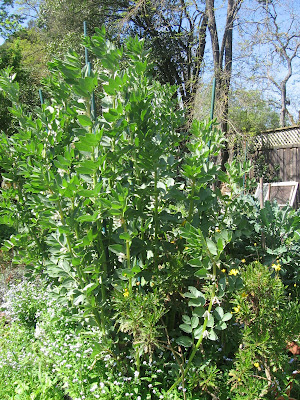
The fava beans are reaching out for the sky with their graceful fans of leaves and elegant blossoms with black accents. Two adjacent beds of seedlings from Cottage Garden Nursery, which were planted out last fall on October 3, are now eight feet and over -- even subtracting the ten inch height of the beds.

The towering stalks form a little forest eco-system all their own, with some volunteer chard sheltering on the shady forest floor layer, most of the blossoms and maturing beans in the understory, and the tenderest new leaves -- so good in salads -- forming the canopy.

Here are the understory beans, starting to size up.

The understory seems to be very popular with all manner of insects -- such as this Common Darter Dragonfly. (Nothing common about it; it's the only one I've ever seen in this garden, which is swarming with dragonflies. I had to do some Web sleuthing to find out what it's called.)

Another mystery insect I was not able to identify: these weird beetles with dramatic African-shield-like markings. Dozens of them can be found scurrying at eye level among the stalks and leaves in the morning sun.

And here's the first sighting of the hornet queen, from March 6. She too seems to favor the mid-level fava forest.

It was almost reassuring to find a common, everyday, garden-variety ladybug sunning herself on a leaf.

And a regular honeybee browsing the blossoms.
B. sometimes wonders why I grow favas at all, because we have only managed to make a meal of them once. I don't dig them under as a cover crop before they form beans, which is the most efficient use of favas as soil enrichment. I let them go full cycle with a fine full crop of fat pods but then get overwhelmed and can't follow through with the laborious processing required to extract the delicate gourmet beans. As I said, that happened once.
I guess I grow them just to watch the show. Well worth it.
No comments:
Post a Comment